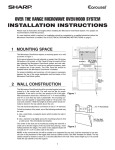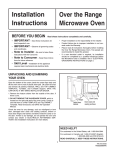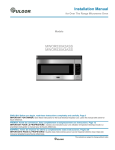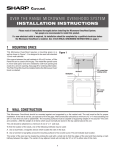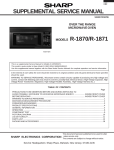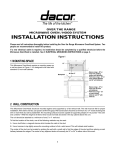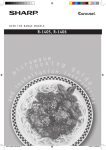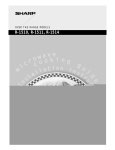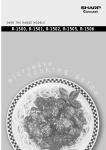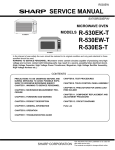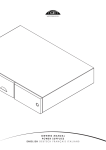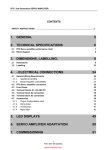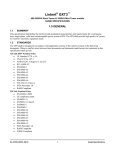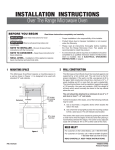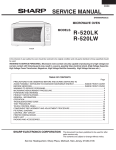Download Viking Built-In Convection Microwave Hood Installation guide
Transcript
Viking Installation Guide IMPORTANT–Please Read and Follow! • Please read all instructions thoroughly before installing the Convection Microwave Hood. Two people are recommended to install this product. • If a new electrical outlet is required, its installation should be completed by a qualified electrician before the Convection Microwave Hood is installed. See 3 ELECTRICAL GROUNDING INSTRUCTIONS on page 2. Mounting Space Wall Construction This Convection Microwave Hood requires a mounting space on a wall as shown in figure 1. It is designed to be used with standard 12-inch wall cabinets. This Convection Microwave Hood should be mounted against and supported by a flat vertical wall. The wall must be flat for proper installation. If the wall is not flat, use spacers to fill in the gaps. Wall construction should be a minimum of 2" x 4" wood studding and 3/8" or more thick dry wall or plaster/lath. The mounting surfaces must be capable of supporting a weight of 110 pounds—the oven and contents—AND the weight of all items which would normally be stored in the top cabinet above the unit. For proper installation and servicing, a 2-inch space is necessary between the top of the range backguard and the bottom of the Convection Microwave Hood. 1 12" 30" The unit should be attached to a minimum of one 2" x 4" wall stud or two 2" x 3" wall studs. 15.5" Backguard At least 2" 30" or more from cooking surface To find the location of the studs, one of the following methods may be used: • Use a stud finder, a magnetic device which locates the nails in the stud. 66" or more from floor • Use a hammer to tap lightly across the mounting surface to find a solid sound. This will indicate stud location. The center of the stud can be located by probing the wall with a small nail to find the edges of the stud and then placing a mark halfway between the edges. The center of any adjacent studs will normally be 16" or 24" to either side of this mark. Convection Microwave Hood 111 Front Street Greenwood, Mississippi 38930 USA Electrical Grounding Instructions Hood Exhaust Duct This appliance must be grounded. This oven is equipped with a cord having a grounding wire with a grounding plug. It must be plugged into a wall receptacle that is properly installed and grounded in accordance with the National Electrical Code and local codes and ordinances. In the event of an electrical short circuit, grounding reduces risk of electric shock by providing an escape wire for the electric current. When the hood is vented to the outside, a hood exhaust duct is required. All ductwork must be metal; absolutely do not use plastic duct. Check that all connections are made securely. Please read the following carefully: Exhaust connection: The hood exhaust has been designed to connect to a standard 3 ¼" X 10" rectangular duct. If round duct is required, a rectangular-to-round adapter must be used. WARNING: Improper use of the grounding plug can result in a risk of electric shock. Rear exhaust: If a rear or horizontal exhaust is to be used, care should be taken to align the exhaust with the space between the studs, or wall should be prepared at the time it is constructed by leaving enough space between wall studs to accommodate exhaust. Electrical Requirements The oven is equipped with a 3-prong grounding plug. DO NOT UNDER ANY CIRCUMSTANCES CUT OR REMOVE THE GROUNDING PIN FROM THE PLUG. Maximum duct length: For satisfac tor y air movement, the total duct length of 3 ¼" X 10" rectangular or 6" diameter round duct should not exceed 140 feet. DO NOT USE AN EXTENSION CORD. If the power supply cord is too short, have a qualified electrician or serviceman install an outlet near the appliance. Elbows, adapters, wall caps, roof caps, etc. present additional resistance to air flow and are equivalent to a section of straight duct which is longer than their actual physical size. When calculating the total length, add the equivalent lengths of all transitions and adapters plus the length of all straight duct sections. Figure 3 shows the approximate feet of equivalent length of some typical ductwork parts. Use the values in parentheses for calculating air flow resistance equivalent, which should total less than 140 feet. The Power Supply Cord and plug must be connected to a separate 120 Volt AC, 60 Hz, 15 Amp, or more branch circuit, single grounded receptacle. The receptacle should be located inside the cabinet directly above the Convection Microwave Hood mounting location as shown in figure 2. Note: • If you have any questions about the grounding or electrical instructions, consult a qualified electrician or serviceperson. Opening for Power Cord E2 figure Ground Receptacle figure figure figure • Neither Viking nor the dealer can accept any liability for damage to the oven or personal injury resulting from failure to observe the correct electrical connection procedures. Tools Recommended for Installation • Saw to cut exhaust opening (if needed) • Electric Drill • Protective Drop Cloth for product and range - you may also use carton for protection figure • Phillips Screwdriver • ½", ⁵⁄₈" and ³⁄₃₂" Drill Bits • 1½" Wood Bit or Metal Hole Cutter (if metal cabinet is used) • Scissors • Measure • Pencil • Tape Installation Hardware Parts Included The INSTALLATION HARDWARE (items 1 - 7) packed with the oven should contain the following: Hardware Kit #5450M023-60 Quantity 1 Wood Screw 5 X 35 mm XTSS750P35000 6 2 Toggle Bolt ³/₁₆ inch LX-BZ0195WRE0 4 3 Top Cabinet Screw 5 X 60 mm XBRS750P60000 2 4 Flat Washer 30 mm diameter XWHS750-16300 2 5 Grommet LBSHC0040MRE0 1 6 Tapping Screw 4 x 12 mm XOTS740P12000 4 7 Exhaust Damper Assembly FFTA-B004MRK0 1 Use with metal cabinets. Surround the power cord opening. Cut to fit. figure Part Name & Code Parts shown not to common scale. figure Item Basic Specifications Microwave Oven Description VMOR205/DMOR205 Overall Width 29-15/16" (76.0 cm) Overall Height from Bottom 16-11/32" (41.5 cm) Overall Depth from Rear 15-9/32" (38.8 cm) Width 17-1/8" (43.5 cm) Depth 13-13/16" Height 8-1/16" (20.5 cm) Overall 1.1 cu. ft. Oven Interior Cutout Width / Height / Depth (35.1 cm) N/A 120VAC/60 Hz Max. Amp Usage Microwave UL Rating 1.60 kw 13.2 amps CSA Rating 1.5 kw 13.0 amps Convection UL Rating 1.60 kw 13.2 amps CSA Rating 1.5 kw 13.0 amps Approx. Shipping Wt. 71 lbs. (32.2 kg) E3 figure Electrical Requirements (Single Phase) UL Rating CSA Rating 116VAC/60 Hz Ventilation System (Preparing Oven for Installation) figure figure This Convection Microwave Hood is designed for adaptation to three types of hood ventilation systems. Select the type required for your installation. Recirculating — non-vented, ductless. Follow installation procedure (A). Recirculating requires the use of the Charcoal Filter, which has been installed in the oven. Hood Fan Unit Horizontal Exhaust — outside ventilation. Follow installation procedure (B). Vertical Exhaust — outside ventilation. Follow installation procedure (C). figure figure figure (A) Recirculating: Non-vented, Ductless Operation • The unit is shipped assembled for recirculating. • The Exhaust Damper Assembly is not required for recirculating exhaust. figure HORIZONTAL EXHAUST: Withdraw hood fan unit carefully and slip wires out of wire box. Hood Fan Unit • Charcoal Filter, included with the unit, is required for recirculating exhaust. HORIZONTAL EXHAUST: Rotate hood fan unit 180˚ so that exhaust ports are facing rear of oven unit. Fan Cover Bracket figure • CAUTION: Do not pull or stretch hood fan wiring. figure • Replace hood fan unit into the oven unit. Be careful not to pinch the lead wire between the inner bracket and the hood fan unit. figure figure (B) Horizontal Exhaust: Outside Ventilation • Put the lead wire into wire box. figure E4 figure figure figure HORIZONTAL EXHAUST: Remove and save 4 screws. Remove fan cover bracket. figure Exhaust Damper Assembly figure figure figure figure figure HORIZONTAL EXHAUST: Replace the fan cover bracket. Make sure the fan blades are visible through the rear openings in the oven before proceeding. Attach fan cover bracket to unit with 4 screws. The hood fan unit is now rotated for horizontal exhaust operation. (A) Rotate 90˚ figure figure • Remove and save 4 screws and fan cover bracket as shown in figure 5. Withdraw hood fan unit. See figure 6. figure figure (C) Vertical Exhaust: Outside Ventilation Fan Cover Bracket figure figure figure figure Ventilation System (Preparing Oven for Installation) VERTICAL EXHAUST: Rotate hood fan unit 90˚ so that the fan blade openings are facing the top of the oven. Replace hood fan unit into oven unit. • Put the lead wire into the box. figure • Replace the fan cover bracket. If the cover does not fit properly, the hood fan unit is improperly placed. Follow the steps in figure ! again. Exhaust Damper Assembly figure figure figure (A) figure figure figure HORIZONTAL EXHAUST: Attach the Exhaust Damper Assembly to the back of the mounting plate by sliding it into the slits in the same direction as the arrow. Using Tapping Screw 4x12 from the INSTALLATION HARDWARE, tighten into place. figure • Attach the fan cover bracket to the oven unit. (B) figure figure E5 igure figure igure re VERTICAL EXHAUST: Attach the Exhaust Damper Assembly to the fan cover on the top of the outercase cabinet by sliding it into the slits in the same direction as the arrow mark. Tapping Screw 4x12 from the INSTALLATION HARDWARE, tighten into place. Mounting Plate • Separate 4 Toggle Bolts, packed in the INSTALLATION HARDWARE, from the Toggle Nuts. figure figure figure Before insertion, be sure you leave a space more than the thickness of the wall between the Mounting Plate and the end of each of the Toggle Nuts (in the closed position). If you do not leave enough space, the Toggle Nut will not be able to open on the other side of the wall. Also, once a Toggle Nut opens, it cannot be withdrawn from the hole; therefore make sure all of the Toggles are in the correct position before insertion. figure figure figure figure Note: THIS OVEN CANNOT BE PROPERLY INSTALLED WITHOUT REFERRING TO THE MOUNTING INSTRUCTIONS FOUND ON WALL AND TOP CABINET TEMPLATES. figure figure Oven Installation (A) figure figure figure figure figure Utilization of the carton may make installation easier. Space more than wall thickness (B) figure figure Mounting Oven to the Wall • Refer to instructions in Wall Template. figure figure MOUNTING PLATE: Align the Mounting Plate carefully and hold in position while tightening Toggle Bolts. Pull Toggle Bolt toward you and turn clockwise to tighten. figure figure MOUNTING PLATE: Use wood screws to attach mounting plate to the stud or studs. Use Toggle Bolts to attach mounting plate through the holes at A, B, C and D UNLESS THOSE HOLES ARE LOCATED ON THE STUD. Insert one Toggle Bolt into A, B, C and D where appropriate (these correspond to holes of the Wall Template) and put the Toggle Nuts onto the Toggle Bolts. figure Mounting Plate figure figure figure Toggle Nut figure figure figure Toggle Bolt (B) Top Side Wall figure figure figure E6 figure figure figure figure figure MOUNTING OVEN TO THE WALL: Place carton upside down. figure Cutting Line MOUNTING PLATE: Position the Mounting Plate with the Toggle Bolts attached at the wall location and insert Toggle Nuts and Bolts through the holes in the wall with the Toggle Nuts closed. Use Wood Screws to attach the Mounting Plate to studs. (A) Oven Installation (B) MOUNTING OVEN TO THE WALL: Hang the (B)oven on the lower edge of the mounting plate. Take care that the power cord is able to clear the edge of the hole as the oven is rotated upward. (In the case of a non-recessed bottom in the top cabinet, the hole for the cord may need to be enlarged.) Remove the carton portions. figure figure figure MOUNTING OVEN TO THE WALL: Using cutting line around the carton, cut into two pieces (A) and (B). figure figure figure (B) figure (B) (A) figurefigure (B) figure figure figure figure figure figure figure (A) (C) (D) (B) MOUNTING OVEN TO THE WALL: Place the oven and the carton portions together on the top of the range. Slide carton toward backguard until it stops. Align the lower back edge of the oven with the mounting plate. Thread the power supply cord through the hole made in the bottom of the top cabinet. Mounting Screws figure figure MOUNTING OVEN TO THE WALL: Tighten the two unit Mounting Screws located in the grease filter openings. (C) (D) E7 (C (B) figure figure figure figure Oven Installation (C) (D) Deflector MOUNTING DEFLECTOR: Secure the deflector with 3 Tapping Screws 4 x 12mm, packed in the Installation Hardware. figure MOUNTING OVEN TO THE WALL: Install Grease Filters by fitting into the opening. Push back and up into place. (C) Checklist for Installation (D) • Make sure the unit has been installed according to all of the Installation Instructions and the Wall and Top Cabinet Templates. MOUNTING OVEN TO THE WALL: Use the two Top Cabinet Screws (C) and two Flat Washers (D), supplied in the INSTALLATION HARDWARE, to attach the unit to the top cabinet. • Plug in the power cord. • Keep the Operation Manual. Viking Range Corporation 111 Front Street Greenwood, Mississippi 38930 USA (662) 455-1200 For product information, call 1-888-VIKING1 (845-4641) or visit the Viking Web site at vikingrange.com F20380 E8 TINSEB505MRR0








